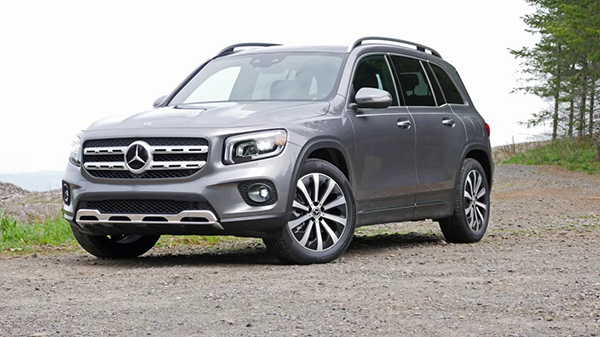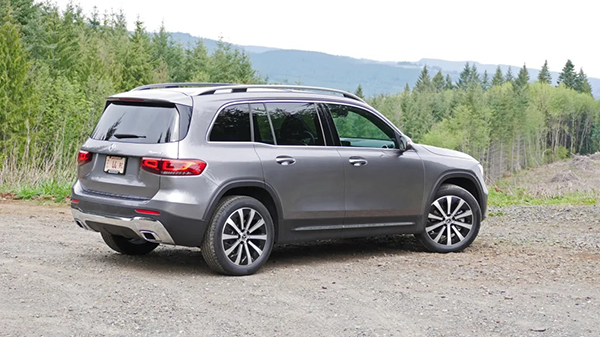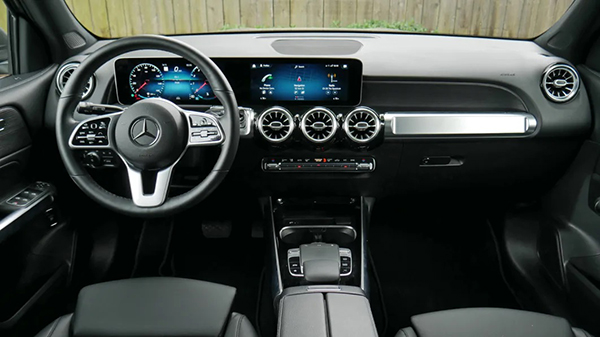Most small luxury SUVs are difficult to recommend. They’re usually too small, too chintzy and too unrefined for the prices they command. We’d normally recommend getting a well-equipped and more spacious non-luxury SUV instead. The 2023 Mercedes-Benz GLB-Class is an exception. It’s distinctive, versatile and stylish in a way that its competitors are not. It may start north of $40,000, but it looks, feels and performs like it should cost that much. There’s actual value beyond that fancy three-pointed emblem, and we thoroughly recommend it as a result.

A big reason for the GLB’s transcendent appeal is its extra-large size for the segment and extra-boxy shape. Add in the versatility of a sliding back seat, and you have a subcompact SUV with a midsize SUV’s interior space. We were stunned by how much its cargo area could swallow. However, besides the cabin’s packaging, its striking design stands out in a segment that often comes across as a bit cheap. The bold rotary air vents and pretty dual-screen infotainment system carry a lot of the weight, but materials quality is better than average for the segment, too. And although the GLB is indeed built to a price on less sophisticated bones than its pricier, more refined GLC sibling, we think it’s a drop-off that’s more than fair for the price. In fact, we can easily see someone happily choosing a GLB over a GLC just because they like it better, with saving money as a bonus. We can’t say the same thing about a BMW X1, Audi Q3, Lexus UX or even the Mercedes-Benz GLA.
What are the GLB interior and in-car technology like?
Mercedes-Benz put quite a bit of thought into the GLB’s interior packaging. It offers lots of clever storage in both the passenger cabin and cargo area, making it more practical than most luxury offerings in this segment (and indeed many others). The GLB’s driving position is excellent, and its front- and second-row seats are comfortable and supportive with plenty of adjustment.
The GLB is on the inexpensive side for a Mercedes-Benz, but the quality of materials and available options are on par or better for expectations at this price point. The fancier options will drive up the price, of course, but even the fundamental components are high-quality and precise.
Every GLB includes the last iteration of Mercedes-Benz’s MBUX infotainment suite, which is controlled by your choice of a central touchscreen (7 inch standard, 10.25 inch available), center console touchpad, steering wheel controls and natural-language commands. While we like this “have it your way approach” and appreciate this system’s rapid responses and pretty graphics, it just isn’t easy to use. Having only three icons on the home screen leads to far too much swiping and clicking, many icons are too small and the same color as the background, and there’s quite frankly just an overwhelming number of functions to control and settings to change.

How big is the GLB?
The GLB’s wheelbase is closer to that of many midsize offerings, and its overall length exceeds that of most competitors. You don’t really notice this behind the wheel – it still feels pretty small – and this extra length combined with the boxy design results in the GLB being a cargo-hauling rockstar. On paper, Mercedes says the GLB offers 24 cubic feet with the second-row seats up, but in reality, there’s actually far more than that number would imply. Its rear load floor can be lowered to accommodate larger items, but even with the floor in its standard position, the GLB can swallow more cargo than crossovers in the bigger, pricier compact segment.
This extra length translates into tons of second-row space, where passengers will find sliding and reclining seats for extra comfort (you don’t get those in the mechanically related GLA). The combination of fold-down seatbacks and sliding bases can also be exploited for additional cargo space if the roomy hatch alone will not suffice, making the GLB a versatility rockstar, too.
The GLB also has available third-row seating, which its smaller competitors and even those in the larger compact class lack. We suppose this option doesn’t hurt, but these optional rearmost seats just aren’t that habitable, even for kids. We’d skip them or get a non-luxury three-row vehicle for the same price.
What are the GLB 250 and AMG 35 fuel economy and performance specs?
The GLB 250 name indicates that the GLB in question has the base engine: a 2.0-liter turbocharged inline-four producing 221 horsepower and 258 pound-feet of torque. This is on-par for its segment. It has an eight-speed dual-clutch automated manual transmission. Front-wheel drive is standard and with it, the GLB is rated at 24 mpg city, 32 mpg highway and 27 mpg combined. The optional 4Matic all-wheel-drive system knocks those ratings down to 22/30/25 mpg, respectively. Mercedes-Benz says the GLB 250 will do 0-60 in 6.9 seconds. That’s respectable for a CUV of this size.
The Mercedes-AMG GLB 35 also has a 2.0-liter turbo, but it’s been worked over by Mercedes’ AMG tuning division to produce 302 hp and 295 lb-ft of torque. It’ll hit 60 in 5.1 seconds. The eight-speed DCT and standard all-wheel drive are also special AMG versions. Fuel economy estimates for 2023 were not available at the time of this writing, but should be roughly the same as those for 2022: 20 mpg city, 27 mpg highway and 22 mpg combined.
There is technically an electric GLB available, although it’s officially known as the Mercedes-Benz EQB. You can read our EQB first drive review here.

What’s the GLB like to drive?
The GLB 250 is more about luxury and comfort than performance. Thanks to its long wheelbase and supple suspension, it delivers in spades for this segment. The optional adaptive suspension will tighten up the handling on demand, but even with that option that we’re guessing will rarely show up on dealer lots, the GLB 250 never rises to the level of “fun to drive.” That’s perfectly OK, though – it doesn’t need to be. As for what’s under the hood, the GLB 250’s standard four-cylinder provides plenty of punch but does come off a little thrashy compared to what you’ll experience in pricier Benz models. Indeed, overall refinement is where the GLB shows its lower price tag. The ride, steering, throttle and transmission response, and driving experience in general are quite simply less sophisticated, but it’s a reduction that’s at least commensurate with that price tag and actually not as great as what you’ll find missing in the BMW X1, Audi Q3 and others in the segment.
As for the AMG GLB 35, it is legitimately fun even if it doesn’t quite reach the level of “extra-tall hot hatch” as the smaller GLA 35 does. The larger footprint and extra tallness result in it being not nearly as agile or darty. Nevertheless, like the GLA and other AMG 35 models, the GLB 35 is just “on” from the second you pop it into Drive. The snappy and quick eight-speed dual-clutch automatic transmission cracks off upshifts with a pop that accentuates and underlines every shift. Indeed, the level of drama and added theater encourages a heavy right foot. And thanks to its AMG-tuned chassis, you can still happily hustle this little crossover around a winding road. With the Sport drive mode selected, body motions are nicely controlled with the stiffness and sharpness you’d expect from an AMG. Steering response is a bit numb, though, and its weighting isn’t as sharp as other AMG 35s.
What is the 2023 GLB-Class price?
The 2023 Mercedes-Benz GLB 250 starts at $40,850, including the $1,050 destination charge. The all-wheel-drive GLB 250 4Matic starts at $42,850. The AMG GLB 35 starts at $52,550.
The GLB offers far more customization than is typical at this price point. There are the usual packages, including the $1,750 Premium package that adds the pair of 10.25-inch interior displays, but many features like a panoramic sunroof and heated/ventilated front seats are stand-alone options. This means it can be difficult to find exactly what you want in stock at a dealer lot, but it also means that if you have some patience, you can order exactly what you want and not pay for stuff you don’t.
Another key option to consider is the AMG Line package that adds unique styling elements to the GLB 250. You can see the difference below with the AMG Line at the right. The full-blown AMG GLB 35 is then below.
What are the GLB safety ratings and driver assistance features?
The GLB 250’s standard driver assistance equipment includes forward collision warning with automatic emergency braking and pedestrian detection, blind-spot and rear cross-traffic warning, and a driver inattention monitor. The Driver Assistance package adds a mountain of systems, most of which are better executed than many comparable systems. These include lane-keeping assist, automated evasive steering assist for the blind-spot and forward collision warning systems, automatic emergency braking for the rear cross-traffic warning system, a higher speed threshold for the forward automatic emergency braking system, automated speed reduction based on posted speed limits (you can turn this one off like most of these systems), Mercedes’ Pre-Safe pre-crash preparation systems, and Mercedes excellent Distronic adaptive cruise control system with stop-and-go capability and lane-centering steering assist.
Should all of that still fail to prevent a crash, the NHTSA gave the GLB four out of five stars for overall frontal crash protection, and five stars for overall side crash protection. The Insurance Institute for Highway Safety hasn’t tested it.
2023 Mercedes-Benz GLB 250 4Matic Lovable Little Box
28/09/2022
No Comments
Mercedes-Benz | Mercedes-AMG
Click to rate this post
[Total: 1 Average: 5]